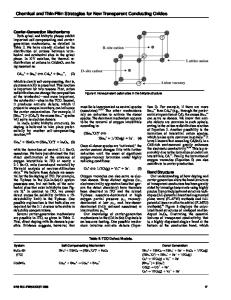Transparent Conducting Oxides for Photovoltaics
- PDF / 331,801 Bytes
- 6 Pages / 612 x 801 pts Page_size
- 80 Downloads / 366 Views
Conducting Oxides for Photovoltaics
Elvira Fortunato, David Ginley, Hideo Hosono, and David C. Paine Abstract Transparent conducting oxides (TCOs) are an increasingly important component of photovoltaic (PV) devices, where they act as electrode elements, structural templates, and diffusion barriers, and their work function controls the open-circuit device voltage. They are employed in applications that range from crystalline-Si heterojunction with intrinsic thin layer (HIT) cells to organic PV polymer solar cells. The desirable characteristics of TCO materials that are common to all PV technologies are similar to the requirements for TCOs for flat-panel display applications and include high optical transmissivity across a wide spectrum and low resistivity. Additionally, TCOs for terrestrial PV applications must use low-cost materials, and some may require device-technologyspecific properties. We review the fundamentals of TCOs and the matrix of TCO properties and processing as they apply to current and future PV technologies.
Introduction There is a plethora of emerging approaches to low-cost, high-efficiency solar cells. Nearly all of these photovoltaic (PV) technologies employ transparent conducing oxides (TCOs) as an integral part of the basic device structure. These solar cell architectures are based on the use of new lower-cost semiconductors, thin films of conventional semiconductors, and organic– inorganic hybrids, and many are rapidly attaining commercial viability. Each PV technology has different requirements for the TCO layer, leading to a reexamination of these materials. Coupled to this is an effort to make conventional cells more efficient by improving the junction characteristics. As can be seen in Table I, many of the needs and requirements of new PV technologies extend well beyond the conventional TCO characteristics of transparency and conductivity. There is, for instance, an increasing desire to employ TCO layers as diffusion barriers, to control the contact work function, to provide an interface with organic and other materials, and to have the TCO also act as a light trap. Low process temperatures and increased process flexibility are critical for many devices. This need for improved performance in a wide range of areas coupled with the ever-rising price
242
of In is driving a renaissance in the investigation of novel TCOs for PV applications. PV devices require at least one electrode that can provide both optical access and a low-resistance electrical connection. Materials that combine optical transparency over much of the solar spectrum with reasonable electrical conductivity generally fall into three classes: very thin pure metals, highly doped conjugated organic polymers, and degenerately doped wide-bandgap oxide or nitride semiconductors. For PV applications, the choice of TCO is driven by additional considerations, including work function, band alignment, materials compatibility, processing, and cost. The focus of this article is on the selection and use of TCOs for current and future
Data Loading...











